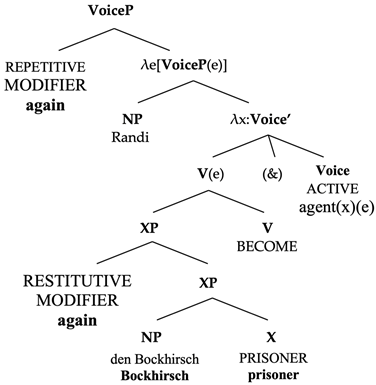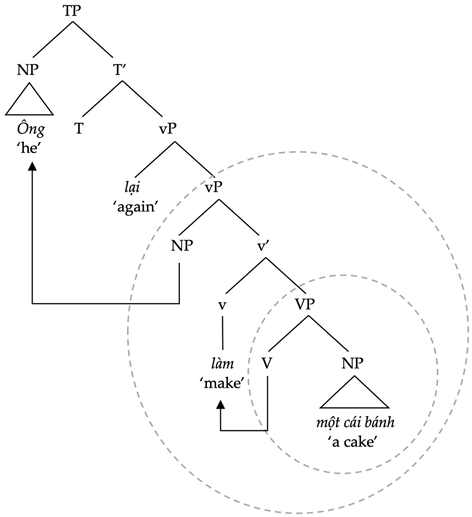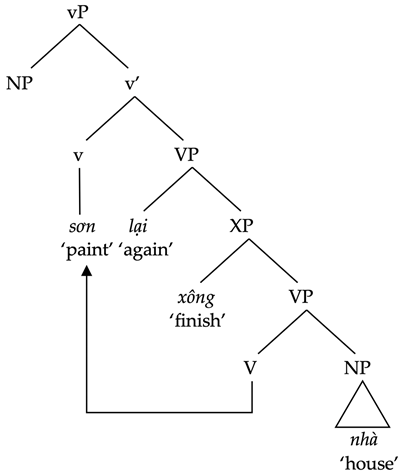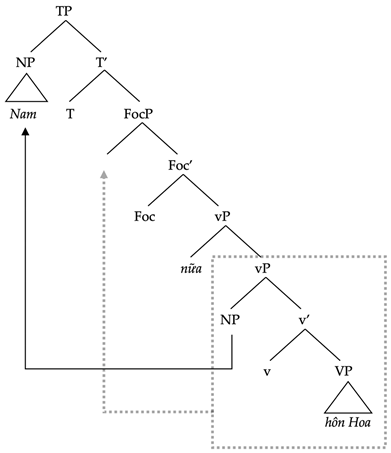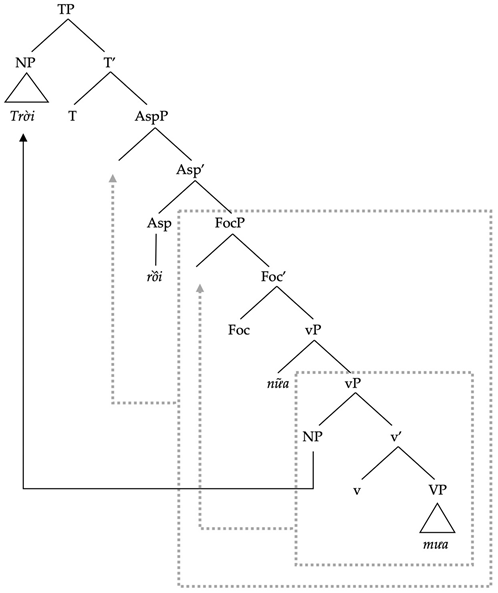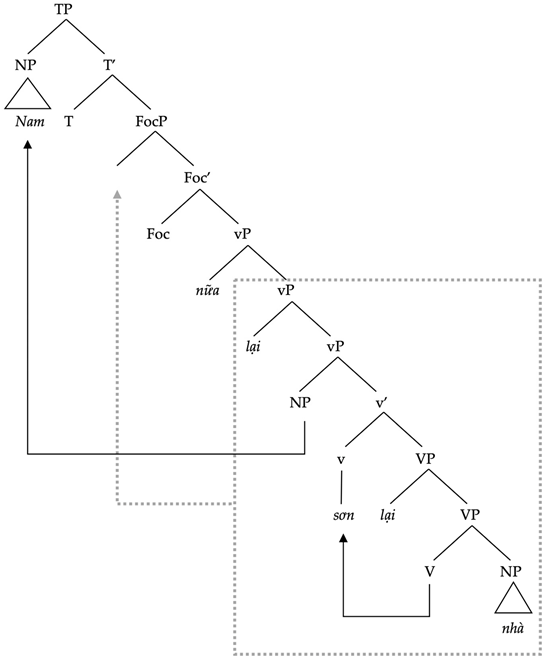1. Introduction
This work investigates the adverbs of repetition in Vietnamese,
lại and
nữa, and proposes syntactic accounts for them. The adverb
lại can be used alone or with the particle
nữa to express the meaning of ‘‘again’’ (
Nguyễn, 1997), as shown in (1).
The word
lại in Vietnamese can be used as a verb meaning “to come”, an adverb, a modal particle conveying the speaker’s attitude, or a sub-element in a sentence connector (
Thompson, 1987;
Nguyễn, 1997;
Trần, 2023, and others). See (2a)–(2d).
| (2) | a. | Em | hãy | lại | đây | với | anh! | | |
| | | you | IMP | come | here | with | me | | |
| | | ‘Come here to me, please!’ (Trần, 2023, p. 252) | | |
| | b. | Tôi | lại | yêu | anh ấy | như | ngày | nào. | |
| | | I | again | love | him | as | day | which | |
| | | ‘I fell in love with him again like before.’ (Trần, 2023, p. 255) | |
| | c. | Vì sao | khi | con | kéo | đàn, | bà | |
| | | why | when | I | play | violin | grandma | |
| | | lại | khóc | vậy | mẹ? | | | |
| | | LAI | cry | such | mother | | | |
| | | ‘Why does grandma cry when I play the violin, mom?’ (Trần, 2023, p. 261) |
| | d. | Ngược lại / | Trái lại, | anh ta | rất | chăm chỉ. |
| | | however | however | he | very | hard-working |
| | | ‘However, he is very hard-working.’ (Trần, 2023, p. 263) |
In this work, we focus on the repetitive use of
lại. It has been pointed out that different syntactic positions of
lại result in different readings (
Thompson, 1987;
Nguyễn, 1997;
Phan, 2013, etc.); see (3a,b). When the adverb
lại precedes a verb, it has a repetitive reading. When the adverb
lại follows a verb, it can only yield a restitutive reading. According to
Phan (
2013), in (3a), the entire event of the subject writing a letter is repeated, while, in (3b), only the result state of the event (i.e., the letter having been written) re-occurs.
2,3Stechow (
1996) postulates a structural analysis for the ambiguous readings of the adverb
wieder, “again”, in German and argues that the ambiguity of
wieder arises from different modifying scopes.
Beck and Johnson (
2004) further apply this analysis to the ambiguity of the adverb
again in English (see also
Beck & Snyder, 2001;
Beck, 2006). Inspired by these analyses, we propose that the preverbal
lại in Vietnamese adjoins to vP. The modifying scope of the preverbal
lại can be the entire event or a result state of the event. This gives rise to the two readings, namely the repetitive and restitutive readings. In addition, we argue that the postverbal
lại adjoins to VP, and it can only modify the result state of the predicate vP. Therefore, it only yields the restitutive reading. We also show that syntactic tests support the proposed analyses of the preverbal
lại and the postverbal
lại.
The word
nữa, which occurs after the predicate, expresses the meaning “more, in addition, also”, as shown in (4). It can also denote the repetition of an event, as in (5).
| (4) | Ông | dùng | cơm | nữa | thôi? |
| | you | have | rice | more | SFP |
| | ‘Are you going to eat more rice?’ (Thompson, 1987, p. 271) |
| (5) | Hôm nay | trời | mưa | nữa | rồi. |
| | today | sky | rain | more | PERF |
| | ‘It is raining again today.’ |
We propose that nữa adjoins to vP, and, furthermore, it triggers the merger of a FocusP on the phrase structure, to which vP moves. This results in the predicate-final position of nữa.
4. The Adverb nữa and Its Syntactic Position
In this section, we discuss the grammatical properties of the adverb
nữa, “more, in addition, also” in Vietnamese. Before delving into the discussion of
nữa, let us introduce the concept of “incremental reading” first.
Tovena and Donazzan (
2008, p. 91) point out that the repetitive adverb
ancora in Italian can give rise to an incremental reading, which means that an activity is incremented by adding subevents measured along a specific dimension. See (27).
| (27) | a. | Maria sta ancora leggendo. |
| | | ‘Maria is still reading.’ |
| | b. | Maria sta leggendo ancora un libro. |
| | | ‘Maria is reading one more book.’ |
The word
ancora in (27a) denotes a meaning comparable to “still,” and the one in (27b) denotes a meaning similar to “more.” The incremental interpretation can be thought of either as a repetition of events or as a continuation of an activity by adding more object units. The adverb
nữa in Vietnamese is quite similar to
ancora, as it yields an incremental reading, shown in (28) and (29).
| (28) | Hôm nay | trời | mưa | nữa | rồi. | | |
| | today | sky | rain | more | PERF | | |
| | ‘It is raining again today.’ | | |
| (29) | Nam | có thể | ăn | một | bát | cơm | nữa. |
| | Nam | can | eat | one | bowl | rice | more |
| | ‘Nam can eat one more bowl of rice.’ |
Now, we turn to the syntactic position of
nữa. First, similar to the preverbal
lại, the adverb
nữa can occur with a stative or dynamic predicate; see (30) and (31). When it occurs with a stative predicate, the perfect aspect particle
rồi is required, as shown in (31).
| (30) | a. | Nam | hôn | Hoa | nữa. | | [dynamic] |
| | | Nam | kiss | Hoa | more | | |
| | | ‘Nam kissed Hoa again.’ |
| | b. | Nam | đánh | Hoa | nữa. | | [dynamic] |
| | | Nam | hit | Hoa | more | | |
| | | ‘Nam hit Hoa again.’ |
| (31) | a. | Nam | thích | Hoa | nữa | *(rồi). | [stative] |
| | | Nam | like | Hoa | more | PERF | |
| | | ‘Nam likes Hoa again.’ |
| | b. | Nam | lại | béo | nữa | *(rồi). | [stative] |
| | | Nam | again | fat | more | PERF | |
| | | ‘He gets fat again.’ |
Second,
nữa must follow postverbal manner adverbs, such as, for instance,
từ từ, “slowly”, in (32). The reverse order is ungrammatical.
| (32) | a. | Nam | ăn | từ từ | nữa. |
| | | Nam | eat | slowly | more |
| | | ‘Nam ate slowly too.’ |
| | b. | *Nam | nữa | ăn | từ từ. |
| | | Nam | eat | more | slowly |
Third,
nữa must follow the completive marker
xông, “finish”, as shown in (33).
| (33) | a. | Nam | (còn) | ăn | bánh mì | xông | nữa. |
| | | Nam | even | eat | bread | finish | more |
| | | ‘Nam even finished the bread.’ |
| | b. | *Nam | (còn) | ăn | bánh mì | nữa | xông. |
| | | Nam | even | eat | bread | more | finish |
Fourth,
nữa must precede the perfect aspect marker
rồi. See (34). When the perfect aspect marker precedes
nữa, the sentence is ungrammatical.
| (34) | a. | Hôm nay | trời | mưa | nữa | rồi. |
| | | today | sky | rain | more | PERF |
| | | ‘It is raining again today.’ |
| | b. | *Hôm nay | trời | mưa | rồi | nữa. |
| | | today | sky | rain | PERF | more |
Fifth,
nữa cannot scope over the epistemic modal adverb
chắc chắn, “surely”. For the sentence in (35), only reading 1 is possible, where
nữa is within the scope of
chắc chắn, “surely”. In reading 2,
nữa is intended to scope over the epistemic modal adverb
chắc chắn. This reading is not available.
| (35) | Nam | chắc chắn | ăn | cơm | nữa. |
| | Nam | surely | eat | rice | more |
| | 1. ‘Nam surely ate rice again.’ |
| | 2. *‘Again, Nam surely ate rice.’ |
Sixth,
nữa cannot scope over the negator
không, “not”, as shown in (36). In this sentence, the negator scopes over the particle
nữa in readings 1 and 2, and both readings are acceptable. In reading 3, the negator is intended to fall within the scope of
nữa. However, this reading is unacceptable.
| (36) | Nam | sẽ | không | đi | Mỹ | nữa. |
| | Nam | will | NEG | go | America | more |
| | 1. ‘Nam doesn’t have any intention to go to the US now.’ (“will” > NEG > nữa) |
| | 2. ‘Nam will not go to the US anymore.’ (NEG > “will” > nữa) |
| | 3. *‘Nam again doesn’t have any intention to go to the US.’
(*nữa >NEG/“will”) |
Seventh,
nữa can scope over the quantificational subject of a sentence, as shown in (37). When the quantificational subject
không ai, “nobody”, in (37) scopes over the particle
nữa, reading 1 is obtained. When the particle
nữa scopes over the quantificational subject, reading 2 is obtained. Both readings are acceptable.
| (37) | Không | ai | đến | nữa. | |
| | NEG | who | come | more | |
| | 1. ‘Nobody came again.’ (NP > nữa) |
| | 2. ‘Again, nobody came.’ (nữa > NP) |
Eighth,
nữa can co-occur with the preverbal
lai and the postverbal
lai. When these three adverbial elements appear in the same sentence, as in (38), the sentence is fully grammatical.
| (38) | Nam | lại | sơn | lại | nhà | nữa. |
| | Nam | again | paint | again | house | more |
| | ‘Nam repainted the house again. (He also repainted other stuff)’ |
In summary, the following two sets of properties are observed with
nữa. See (39) and (40). In linear order, the particle
nữa must follow the postverbal manner adverb
từ từ, “slowly”, and the completive marker
xông, “finish”, and precede the perfect aspect marker
rồi. Regarding the scope property of
nữa, it must fall within the scope of the epistemic modal adverb
chắc chắn, “surely”, and the negator
không, “not”. In addition,
nữa may scope over the quantificational subject of a sentence.
| (39) | Linear order |
| | ![Languages 10 00018 i004]() |
| (40) | Scope |
| | a. | chắc chắn, “surely” > nữa |
| | b. | không, “not” > nữa |
| | c. | Quantificational subject > nữa |
| | | nữa > Quantificational subject |
5. The Proposal
Inspired by the structural analysis of
Stechow (
1996), we propose an analysis for the preverbal
lại, the postverbal
lại, and
nữa that is partially structural and partially focus-semantic (see
Beck, 2006;
Ippolito, 2007; and
Csirmaz & Slade, 2020, for more focus-based accounts of repetitive adverbs). We agree with Stechow’s proposal that the different readings of a repetitive adverb result from its syntactic position, rather than lexical ambiguity (see
Dowty, 1979; and
Fabricius-Hansen, 1983, among others). However, the approach we adopt is more flexible, since syntactic adjacency does not completely determine the reading of the adverb in question (for details, see below). We argue that the repetitive adverb can target an element within its c-commanding domain and not only the constituent to which it is directly adjoined.
First, based on our observation of the preverbal
lại (summarized in (18)), we propose that the preverbal
lại adjoins to vP. Semantically, as a focus particle, it can be associated with the entire event, namely vP, or only with the result state of the event, namely VP. This results in two possible readings, i.e., the repetitive reading and the restitutive reading. See the example in (41) and its syntactic structure in (42). Note that, in Stechow’s theory,
wieder (and also the English adverb
again; see
Beck & Johnson, 2004) can only modify the syntactic domain to which it is directly adjoined. However, in the case of Vietnamese (and Mandarin, too; see
Lin & Liu, 2009), non-adjacent focalization is possible. In other words, when
lại is adjoined to vP, focalization of the complement of vP, namely VP, is possible in Vietnamese (and Mandarin). This state of affairs is actually a normal case rather than an exception. An example is the focus adverb
only in English. In the English sentence “
John only bought books”,
only may focalize the verb
bought or the object NP
books. For example, we can have the following two contrasts in mind: “
John only bought books and did not buy other things”, in which case
books is focus-marked; or alternatively, “
John only bought books and did not borrow them”, in which case the verb
bought is focus-marked. Having the English adverb
only as a paradigm example, we claim that the preverbal
lại in Vietnamese is such a focus particle. It can focalize a constituent that is within its c-command domain, immediately adjacent to it or otherwise. We assume that the focalization function of the preverbal
lại is carried out by the probe–goal relation of current syntactic theory, which does not require adjacency.
| (41) | Ông | lại | làm | một | cái | bánh. |
| | he | again | make | one | CL | cake |
| | ‘He made a cake again.’ (repetitive or restitutive) |
| (42) | Preverbal lại (circled areas = possible focus targets) |
| | ![Languages 10 00018 i005]() |
The proposed analysis explains the position of
lại when it co-occurs with other elements, as shown in (16) and repeated in (43).
| (43) | ![Languages 10 00018 i006]() |
The analysis in (42) can account for the structural properties of the preverbal
lại shown in (43). If the preverbal
lại adjoins to vP, it will necessarily be lower than CP-level adverbs and TP-level adverbs, such as
quả nhiên, “indeed”,
có lẽ, “probably”, and
thông thường, “normally”. In addition, since it is on vP and thus precedes the head v, it naturally precedes the passive maker
bị, which is assumed to be the head of a predicate (equivalent to
v) (see
Bruening & Tran, 2015). And, since we assume that the preverbal
lại adjoins to the outer-most layer of vP, it is higher than and, hence, precedes the vP-level adverbs
vô tình, “unintentionally” (vP), and
liên tục, “continually” (vP).
We also noted that the preverbal
lại may occur with dynamic and stative predicates, but the perfect aspect marker
rồi is required when it occurs with a stative predicate, as in (16) and (17), repeated below.
| (44) | a. | Nam | lại | hôn | Hoa. | | [dynamic] |
| | | Nam | again | kiss | Hoa | | |
| | | ‘Nam kissed Hoa again.’ |
| | b. | Nam | lại | đánh | Hoa. | | [dynamic] |
| | | Nam | again | hit | Hoa | | |
| | | ‘Nam hit Hoa again.’ |
| (45) | a. | Nam | lại | thích | Hoa | *(rồi). | [stative] |
| | | Nam | again | like | Hoa | PERF | |
| | | ‘Nam likes Hoa again.’ |
| | b. | Nam | lại | béo | *(rồi). | | [stative] |
| | | Nam | again | fat | PERF | | |
| | | ‘Nam gets fat again.’ |
This phenomenon is similar to the adverb
you, “again”, in Mandarin. When
you, “again”, occurs with a stative predicate, it also needs the presence of the perfect aspect marker
le.
Lin and Liu (
2009, p. 1188) argue that, when
you, “again”, adjoins to a static predicate, it turns the predicate into a dynamic one, namely a change-of-state predicate. We propose that the preverbal
lại exhibits the same function. When it occurs with a static predicate, it turns the predicate dynamic. The presence of the perfect aspect marker
rồi is therefore required to indicate that the predicate is now a dynamic one.
8As to the postverbal
lại, we propose that it adjoins to the lexical VP as its outer-most layer. See (46) and (47) as a demonstration. In sentence (46), the verb
làm, “make”, raises to the head of vP, resulting in the postverbal position of
lại. Since the postverbal
lại only c-commands the VP, its focus domain is limited to the result state of the predicate. Consequently, only the restitutive reading is available for the postverbal
lai. This analysis is also compatible with
Phan’s (
2013) proposal, which posits a projection lower than the vP which denotes the result state of the asserted event, ResultativeP. For simplicity, we use the term VP here.
| (46) | Ông | làm | lại | một | cái | bánh. |
| | he | make | again | one | CL | cake |
| | ‘He made a cake again.’ (only restitutive) |
| (47) | Postverbal lại (circled area: possible focus target) |
| | ![Languages 10 00018 i007]() |
This analysis accounts for the structural properties of the postverbal
lại shown in (24), repeated as in (48).
| (48) | ![Languages 10 00018 i008]() |
First, if the postverbal
lại adjoins to VP, it should precede the object. This accounts for the fact that the postverbal
lại must precede the object in a sentence. Second, if the postverbal
lại adjoins to VP as its outer-most layer, other VP-level elements should be lower than it. This explains the fact that the postverbal
lại precedes the postverbal VP-level manner adverb
từ từ, “slowly.” It also explains the fact that
lại precedes the completive particle
xông, “finish”, and the dynamic modal
được, “be able to.”
Phan (
2013) proposes that the particle
xông and the modal
được are heads of the projection CompletiveP and ResultativeP, respectively, both of which occur between a higher VP (roughly equivalent to vP) and a lower VP of a sentence. In our framework, the postverbal
lại is the outer-most layer of the (generalized) VP; thus, it must be higher than these two elements and precede them. We take
xông as an illustration.
9| (49) | Nam | vừa | [sơn | lại | xông | nhà]. |
| | Nam | just | paint | again | finish | house |
| | ‘Nam just finished the house painting.’ |
| (50) | Co-occurrence of the postverbal lại with the other postverbal element |
| | ![Languages 10 00018 i009]() |
In
Section 3.2, we observed that the postverbal
lại can only be used with a dynamic predicate; it cannot be used with a stative predicate, not even with the perfect aspect marker
rồi. See (19) and (20) above. This can be explained by the proposal that the postverbal
lại adjoins to the projection denoting the result state of a verbal predicate, namely VP. Only a dynamic verbal predicate has a result state. Furthermore, we may assume that the result state that
lại modifies must be the result of an agentive action. Since
rồi only introduces a change-of-state meaning to a stative predicate and no agency is brought in, the addition of
rồi cannot save the sentence from ungrammaticality. A piece of evidence for this proposal is that sentences (17a,b), where the presence of
rồi makes a stative sentence with the preverbal
lại grammatical, can only have the repetitive reading. They do not have the restitutive reading. The lack of an acceptable restitutive reading for (17a,b) clearly originates from the fact that stative predicates do not yield a result state, even when they become dynamic by the function of
rồi.
Lastly, we turn to the particle
nữa, which occurs in the predicate-final position. The particle
nữa, in its lexical–semantic nature, is an additive particle that yields an incremental reading. The structural properties of
nữa are shown in (39) and (40), now repeated in (51) and (52).
| (51) | Linear order |
| | ![Languages 10 00018 i010]() |
| (52) | Scope |
| | a. | chắc chắn, “surely” > nữa |
| | b. | không, “not” > nữa |
| | c. | Quantificational subject > nữa |
| | | nữa > Quantificational subject |
We propose that
nữa adjoins to vP. We further propose that
nữa triggers movement of the vP to a higher functional projection, Spec, FocP, resulting in its being stranded behind the predicate.
10 Following the analysis of light predicate raising of
Simpson (
2001), we assume that the motivation for such movement is to defocus the constituent in question. Examples of such movement include the sentence-final particle
kong, “to speak”, in Taiwanese (
Simpson & Wu, 2002) and the sentence-final deontic modal in Cantonese and a number of Southeast Asian languages (
Simpson, 2001). Let us use the sentence in (30a) as a demonstration, repeated as (53), with (54) as its structural analysis.
| (53) | Nam | hôn | Hoa | nữa. |
| | Nam | kiss | Hoa | more |
| | ‘Nam kissed Hoa again.’ |
| (54) | ![Languages 10 00018 i011]() |
This analysis can account for the structural properties of
nữa shown in (51) and (52). First, if
nữa adjoins to vP, VP-level or VP-internal elements such as
từ từ, “slowly”, and
xông, “finish”, should precede it because the whole VP moves to Spec, FocP, and becomes higher than vP. Second,
nữa precedes
rồi because
rồi is the head of the projection AspP, which we assume triggers the raising of its complement (FocP in this case) to its specifier. See (55) and (56) for illustration.
| (55) | Trời | mưa | nữa | rồi. |
| | sky | rain | more | PERF |
| | ‘It is raining again.’ |
| (56) | ![Languages 10 00018 i012]() |
Third, if the particle
nữa adjoins to vP, it cannot scope over TP-level elements such as the epistemic modal adverb
chắc chắn, “surely”, and the negator
không, “not”. In addition, as
nữa adjoins to vP, it should fall within the scope of a subject quantifier. So, the scope relation “quantificational subject >
nữa” in (52c) is obtained. On the other hand, a quantificational subject may undergo quantifier lowering (
May, 1985) and assumes its scope position in Spec, vP. In that position, it falls within the scope of
nữa since
nữa adjoins to vP. In this way, the scope relation “
nữa > quantificational subject” is obtained.
Fourth, our proposal can also account for the co-occurrence of
nữa with the preverbal
lại and the postverbal
lại, as shown in (57) and (58). Sentence (38) is repeated in (57).
| (57) | Nam | lại | sơn | lại | nhà | nữa. |
| | Nam | again | paint | again | house | more |
| | ‘Nam repainted the house again. (He also repainted other stuff)’ |
| (58) | ![Languages 10 00018 i013]() |
